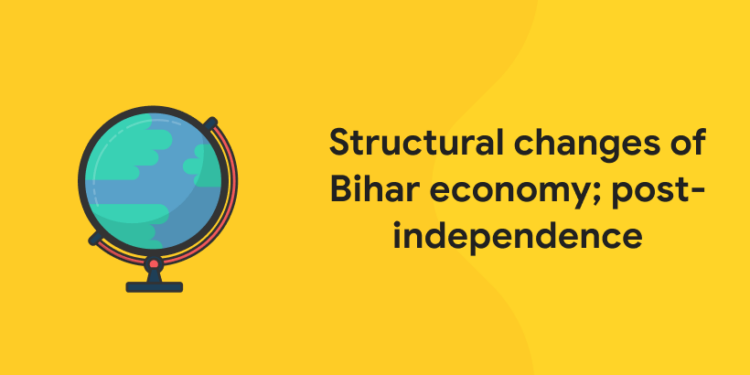Bihar is in India’s east. The state is bordered on the north by Nepal, the east by West Bengal, the west by Uttar Pradesh, and the south by Jharkhand. Because of its proximity to the large markets of eastern and northern India, access to ports like Kolkata and Haldia, and raw material and mineral reserves from neighbouring states, the state enjoys a unique location-specific advantage.
Bihar’s GSDP is expected to reach Rs. 7.45 trillion (US$ 97.39 billion) in 2022-23 at current prices. Between 2015-16 and 2022-23, the state’s GSDP grew at a CAGR (in Rs.) of 10.43 percent. Bihar’s per capita net state domestic product has increased significantly. Between 2015-16 and 2020-21, the state’s per capita NSDP expanded at a CAGR of 10.73 percent (in Rs.) at current prices.
Bihar is one of the country’s most powerful agricultural states. In Bihar, over 80% of the population is employed in agricultural production, which is significantly more than the national average. It is India’s fourth-largest vegetable producer and the eighth-largest fruit producer. Some of the state’s fastest-growing businesses include food processing, dairy, sugar, manufacturing, and healthcare. Other sectors like as education and tourism have been targeted for development, and incentives for information technology and renewable energy projects have been provided.
Attempt Free General Knowledge Mock test! Download Entri App!
Introduction
One of the most important markers of people’s well-being is the economy’s growth and development. In order to grasp the necessity for growth and development and to remain competitive among the global marketplace, debate on the topic is rife in impoverished countries. Unemployment and poverty reduction are constantly part of development plans, and progress is still being made in third-world countries. The mutual interrelationships between the state’s policies, politics, and administrative duties determine how quickly an economy develops. Indeed, as the development agency, the state plays a critical role in the development process, facilitating the process of structural changes in the economy. Economic growth and development are aided by such developments in the economy. The composition of resources in terms of income/output and employment reallocates during this process, as do changes in rural-urban texture in the form of labour migration and changes in labour productivity, all of which contribute to the economy’s total growth (Lewis, 1954; Ranis & Fei, 1961; Hasan, Lamba, & Gupta 2013; Herrendorf, Rogerson, & Valentinyu 2014).
As a result, structural change is clear for an economy’s economic development; this is because structural change is critical for modern economic growth (Syrquin, 1988). And an economy’s sustained expansion necessitates a series of interconnected structural improvements (Chenery & Elkington, 1979). Such interconnected changes occur as a result of structural changes in the sectors, such as labour movements toward more productive sectors, such as from primary to secondary and eventually tertiary.
Bihar’s growth rate over the last decade appears to be highly impressive, drawing scholars and researchers’ attention to the state’s economic trends and possibilities. One of the so-called “BIMARU”1 states has begun to recover from its irritation. During the 1990s, the state’s development process was stifled by the state’s low and irregular growth rate (Singh & Stern, 2014). But After 2005, the state did admirably in all areas under the newly established government’s tenure. It had experienced a surprise double-digit growth rate and was ranked first among the states in terms of growth rate. For structural change in the economy, a large drop in the primary sector’s share and a sustained growth rate of some of the most important sectors are required. In recent years, the service sector’s growth and proportion of income has been impressive. Governance, social structure, and policy implementation are just a few of the important elements whose interaction leads to progress. In Bihar, such interaction has proven to be beneficial to the state’s growth and development prospects.
The role of several industrial sectors in the growth process has also been examined. In two respects, this paper adds to the existing literature. To update the workforce statistics, we used the most recent data for Net State Domestic Product (NSDP) at the 2011-123 base price and the first Periodic Labour Survey (2017-18) data. Second, for the whole study period, this report is based on GSDP and workforce estimates for the undivided state of Bihar. As a result, the scope of this research extends over a two-and-a-half-decade span (i.e.,1993-94 to 2018-19).
Attempt Free General Knowledge Mock test! Download Entri App!
Data and Methodology
This article examines the post-liberalization growth rate pattern and trends, as well as the structural changes in the Bihar economy. The analysis covered the years 1993-1994 to 2018-19, which was then separated into three sub-periods. The first period spans 1993-94 to 2004-05, the second spans 2005-06 to 2011-12, and the third spans 2011-12 to 2018-19. The research uses income data from Bihar’s net state domestic product to achieve this goal. The industries of origin in Bihar have taken the domestic product at the 2011-12 constant price. The income data from 1993-94 to 2018-19 of the various base years were spliced into the same base price of 2011-12 for this purpose. For the sectorwise employment data for Bihar, data from several rounds of the Employment and Unemployment Survey (EUS) and the first periodic labour force survey have been retrieved (NSSO, 2014; PLFS, 2019). In India, the labour force survey is conducted on a regular basis by a national sample survey agency. The national industrial classification-2008 has been used to classify industries by sector.
The workforce estimation, on the other hand, is based on both the primary and secondary activities of workers based on their typical status. Aside from that, data sets from the National Institution of Transforming India (NITI) database and the Economic and Political Weekly Research Foundation have been used (EPWRF). The analysis process is entirely exploratory and analytical. A basic average growth rate average growth rate formula was used to get the growth rate.
Attempt Free General Knowledge Mock test! Download Entri App!
Economic Structure of Bihar
Bihar’s economy is predominantly agrarian, but it has experienced service-oriented expansion in recent decades, with the biggest percentage of GSDP. Jharkhand was split from Bihar in 2000, depriving it of its most vital sources of growth: mining, quarrying, and manufacturing. This area is now part of the new state of Jharkhand. The manufacturing sector, particularly mining and quarrying, lost roughly 30% of its share of Bihar’s overall GSDP as a result of the split, and the state’s economy suffered as a result Mukherji and Mukherji (Mukherji & Mukherji, 2012). However, throughout the last decade, Bihar has shown decent growth rates in both agriculture and service sectors, with a minor increase in the secondary sector. Though structural change in an economy follows a set of steps and does not happen by itself, it is a process that must be followed. The transformation process, on the other hand, is reliant on a number of economic elements, including human capital, improved infrastructure, institutions, and industrial investments. As a result, structural change may be gradual, fast, or episodic (McMillan, Rodrik, & Sepulveda, 2017). Growth enhancing or growth reducing structural change is possible.
As can be seen in most nations, such as India and Thailand, structural transformation has aided the economic growth process in a good manner. In contrast, certain countries, such as Argentina, Brazil, Nigeria, and Zambia, have experienced “growth limiting” structural changes (Ahsan, 2012; Mcmillan, Margaret S & Rodrik, 2011). Prior to 2005, economic growth and acceleration, as well as the rate of structural change, were prolonged.
Attempt Free General Knowledge Mock test! Download Entri App!
Structural Changes in the Economy
In an economy, structural change occurs at both the micro and macro levels. Structural change at the micro level is concerned with the operation of economies in the framework of markets, institutions, a mechanism for resource allocation, and income generation and distribution. Industrialization, urbanisation, and agricultural change are among the macroeconomic processes studied. This manifests itself in changes in the sector’s share of income and employability, as well as total income and productivity development. As a result, at the macro level, the structural shift in income has been examined in terms of net state domestic product in this article.
The Bihar economy grew at a compound annual average growth rate of 5.61 percent from 1993-94 to 2018-19, according to the report. For the period P3 (2004-05 to 2011-12), the economy experienced a significant double-digit CAGR for most sub-sectors and an overall growth rate of around 9%. In various sub-periods of estimation, the growth trends of the three broad sectors appear to be inverted ‘U’ shaped. Many academics have noted that the gross state domestic product (GSDP) has grown at a double-digit rate throughout the same time span (Gupta, 2010; Santra, Kumar, & Bagaria, 2014). Agriculture has lost 20.87 percent of its proportion of the overall NSDP, with a compound average growth rate of 2.33 percent in P1. Despite a high growth rate of 31.30 percent from 2011-12 to 2018-19, mining and quarrying have a small share of the NSDP and the primary sector. However, the reduction in the primary sector’s share was primarily attributable to a drop in the agriculture sub-sector.
In the Secondary sector, the construction sector played a substantial role in terms of both NSDP contribution and P3 growth rate. The compound growth rate for building (3.59 percent) was the lowest of the three periods during the later period. Though, in Bihar’s situation, the tendency is comparable to that of India. Female employees have become more mobile towards village activity, such as agricultural and non-agricultural jobs, as a result of male worker mobility. While migrant remittances have improved rural living standards, agriculture is also the primary factor behind the economy’s growth due to its moderate growth rate. (Sharma & Rodgers, 2012; Sharma & Rodgers, 2015; Sharma & Rodgers, 2016). As a result, the structure of men’s employment has evolved more rapidly than that of women’s across time.
Attempt Free General Knowledge Mock test! Download Entri App!
I hope you found this article useful. The secret to clearing an exam is to prepare methodically and strategically. If you’re a candidate looking to start your dream job but don’t know where to start, our Entri app has you covered. Our staff will provide you with content and insights on the topics that affect you. Become a member of our app today and enroll in one of the many programs available. Stay up to date on various elements of the subject you’re interested in by using the app. Please feel free to leave any questions or concerns in the comments area. We will make every effort to reach back. Remove any self-doubts and negative thoughts from your mind. Make an effort to maintain a clear viewpoint. Consider why you desire this. Concentrate on the positive aspects of your situation and work diligently. Each day is a valuable gift that has been placed upon us, so make the most of it. Make an effort to improve yourself. Today is the day; let’s hope it goes well. Best wishes.












